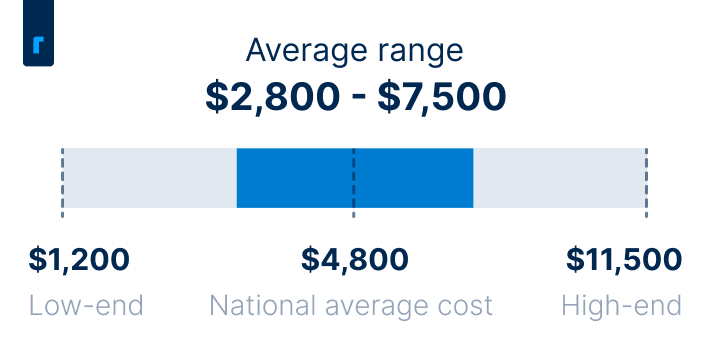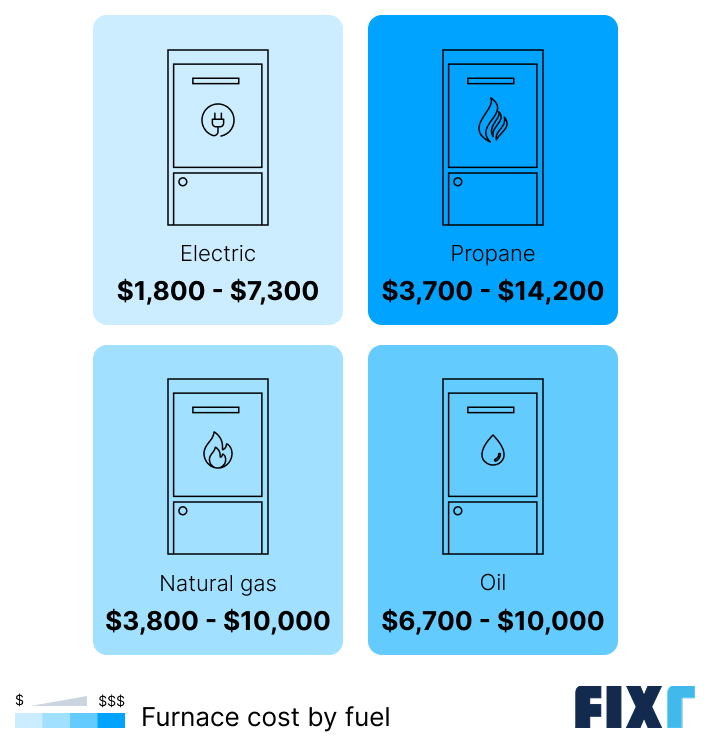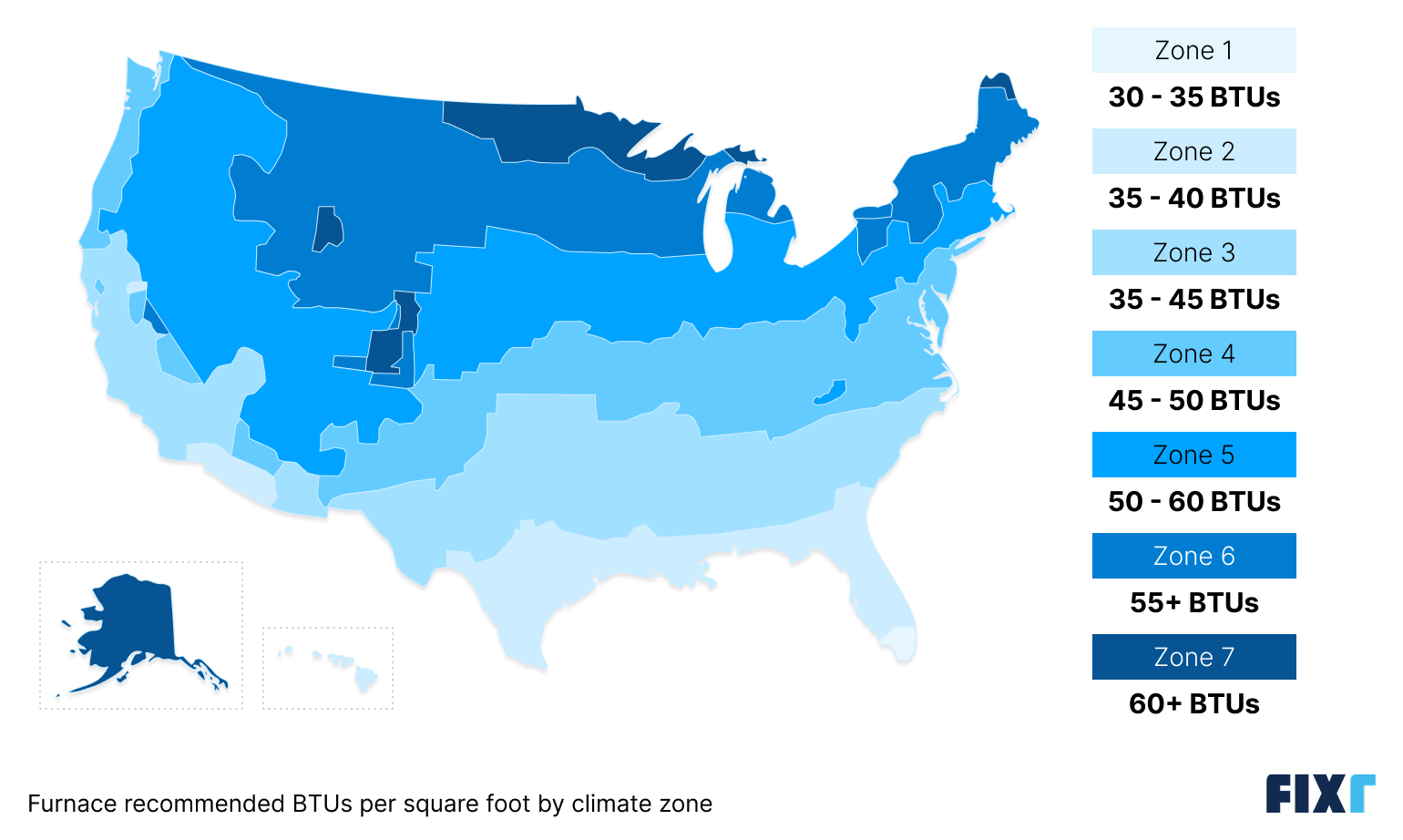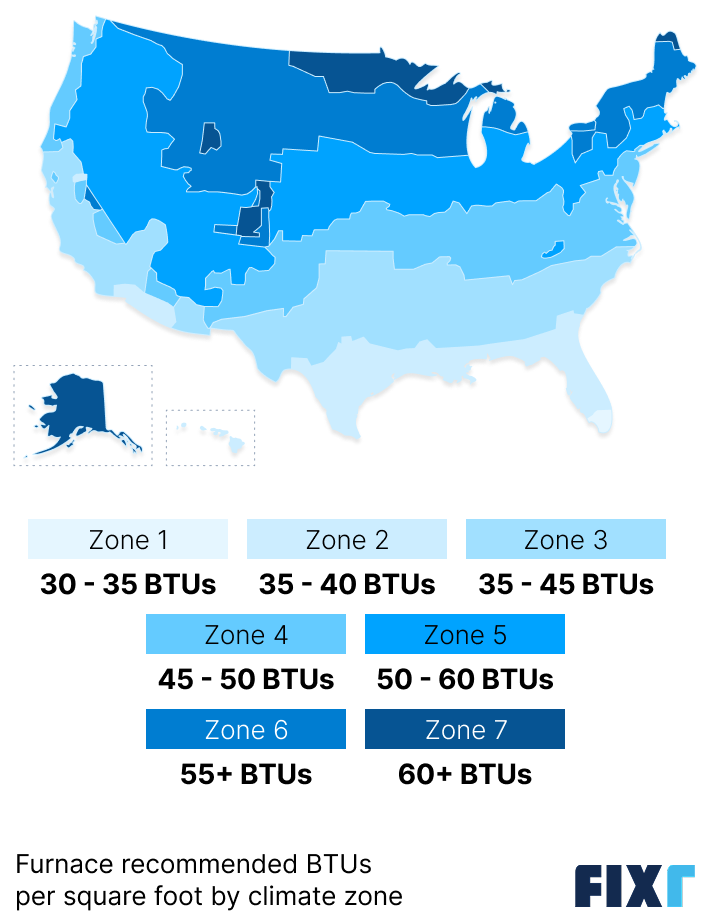Updated: August 20, 2025
Written by Dan Simms
Nieves is a home remodeling editor at Fixr.com with special interest in landscaping, pest control, painting, installation, and repair projects. She brings her work ethic, creativity, and love for teamwork into everything she does, including working with writers and designers at Fixr.com to develop useful and comprehensive guides for homeowners.
Learn moreReviewed by Nieves Martinez
Your furnace is one of the hardest-working appliances in your home, but as it ages, it loses efficiency and can become a major drain on your wallet and your peace of mind. Replacing an old furnace with a new, high-efficiency model can cut your energy bills, improve home comfort, and even prevent dangerous carbon monoxide leaks.
The average cost to replace a furnace is $4,800, and most homeowners pay somewhere between $2,800 and $7,500 for the materials and installation labor. There are many factors that affect the cost of furnace replacement, with the most crucial factors being the fuel source, the heating capacity, and the efficiency rating.
New Furnace Installation Cost


New Furnace Cost by Type
The fuel type you plan on using for your furnace is one of the most important factors to consider to get an accurate estimate. Electric furnaces are the most affordable, costing between $1,800 and $7,300. Propane furnaces are about twice as expensive, totaling between $3,700 and $14,200. Natural gas and oil furnaces are the most popular types, costing between $3,800 and $10,000 and between $6,700 and $10,000, respectively.
Most homeowners who are replacing their furnaces will just keep the same type they already have, since converting to a different fuel source can add thousands of dollars to the installation costs. However, converting from oil to natural gas is a somewhat popular option for improved efficiency and reduced maintenance, and converting from oil or gas to electric is becoming increasingly popular, as many states are beginning to ban gas and oil furnaces.
If you’re not sure what type of furnace to choose, speak with an HVAC professional near you for help. Oil furnaces provide the most heat and are more common in colder climates, natural gas furnaces require a gas connection but have lower running costs and need less maintenance, propane furnaces are good options in remote locations without gas connections in the street, and electric furnaces are best in moderate climates, boast the highest efficiency ratings, and have some of the lowest operating costs, depending on local electricity rates.


Type | Average Cost Installed |
$1,800 – $7,300 | |
$3,700 – $14,200 | |
$3,800 – $10,000 | |
$6,700 – $10,000 |
Furnace Replacement Cost by Size
Furnaces are sized in British thermal units (BTUs), with higher ratings meaning a greater heat output. Sizing your furnace properly for your home is crucial. A furnace that’s too small won’t provide sufficient heat to keep you and your family comfortable and will work overtime to heat your living space, reducing its lifespan and increasing maintenance costs. A furnace that’s too large will cycle on and off rapidly, which tanks its efficiency and can also lead to premature breakdowns and necessary maintenance.
Furnace size is largely based on home square footage, as larger homes naturally need more heating power to warm the larger interior space. You can use the table below to get an idea of what size furnace generally matches home square footage and what the installation will cost.
Home Size (Square Feet) | BTUs | Average Cost Installed |
1,000 | 30,000 – 60,000 | $1,200 – $2,000 |
1,500 | 45,000 – 90,000 | $1,800 – $3,000 |
2,000 | 60,000 – 120,000 | $2,400 – $4,000 |
2,500 | 75,000 – 150,000 | $3,000 – $5,000 |
3,000 | 90,000 – 180,000 | $3,600 – $6,000 |
4,000 | 120,000 – 240,000 | $4,800 – $8,000 |
5,000 | 150,000 – 300,000 | $6,000 – $10,000 |
What Size Furnace Do I Need?
As mentioned above, you can get a general idea of what size furnace you’ll need based on the size of your home, but there are other factors that affect sizing. One major factor that can influence the BTUs you need is your climate zone. Homes in more moderate climates will need much smaller furnaces than homes with a similar square footage in extremely cold climates. Take a look at the table below to see just how big of an impact climate alone can have on your ideal furnace size.


Climate Zone | Recommended BTUs Per Square Foot | Average Total BTUs Needed* |
1 | 30 – 35 | 55,500 – 64,750 |
2 | 35 – 40 | 64,750 – 74,000 |
3 | 35 – 45 | 64,750 – 83,250 |
4 | 45 – 50 | 83,250 – 92,500 |
5 | 50 – 60 | 92,500 – 111,111 |
6 | 55+ | 101,750+ |
7 | 60+ | 111,000+ |
*Note: Total BTUs needed is based on the average home size of 1,850 square feet. Sizing requirements will vary widely with home square footage.
The energy efficiency and insulation quality of your walls, windows, doors, and roof will also matter, with less efficient homes requiring more powerful systems for adequate heat.
With so many factors at play, it’s crucial that you have a professional size your furnace, as they’ll consider home square footage, ceiling height, home age, home energy efficiency, your local climate, and more.
Cost of a New Furnace by Efficiency
The efficiency of your furnace, rated as annual fuel utilization efficiency (AFUE), will also play a role in your upfront costs. A higher AFUE rating means the furnace converts more of its fuel into heat, leading to lower utility bills over time, but it also increases the initial purchase price.
A low AFUE rating of around 80% typically puts the installation cost at the lower end of the price spectrum for your home size, while a high-efficiency furnace will push closer to the high end.
It's important to note that furnaces with an AFUE of 97% or higher may qualify for a tax credit of up to 30% (with a $600 maximum) from ENERGY STAR. Your furnace's fuel type also affects its efficiency, with electric furnaces potentially reaching 100% efficiency, and oil furnaces generally having the lowest AFUE ratings
Labor Cost to Install a Furnace
In total, you can expect new furnace installation costs to total between $300 and $1,800, which means labor accounts for an average of 10% to 40% of your total. Most furnace replacements take between 4 and 10 hours to complete, and hourly rates can range from $75 to $150. Converting from one fuel source to another can involve additional work that can drive up your overall costs.
Furnace Repair vs. Replacement
To help you decide between replacing or repairing your unit, speak with an HVAC technician to discuss the possibilities based on the age of your existing furnace and what it would cost to repair it. If the furnace is repairable, you may want to postpone replacing it for as long as possible, as furnace repairs are almost always more affordable than replacements. Repairs may make more sense if your unit still has 5 or more years of life left in it, but replacing units that have reached their projected lifespan may be less costly in the long run.
Not only will replacing your furnace mean a lower risk of maintenance and additional repairs in the near future, but you’ll also enjoy lower utility bills, greater interior comfort, and improved energy savings when you replace rather than repair.
Here are some signs that it might be time to replace your furnace:
You notice increasing energy costs: Furnaces lose efficiency over time, so older units could be leaving you with unnecessarily high heating bills.
Your furnace is reaching its expected lifespan: If you know your furnace was installed 15 to 20 years ago, it’s reaching the end of its life, and a replacement is best.
You’re facing ongoing repairs or maintenance: If you're constantly calling in your HVAC tech for repairs or to fix breakdowns and your repair costs are adding up, that's a good sign your unit is on its way out and needs replacement.
You notice unusual noises or odors in your home: Buzzing, banging, or grinding noises all suggest an internal issue, which could mean a replacement is necessary. Unusual odors can also mean your furnace is failing, and they could be dangerous, so a replacement is usually ideal.
Your interior is less comfortable than normal: Finally, a living space that’s less comfortable than it used to be can indicate that you need furnace replacement. Keep an eye out for uneven or inadequate heating.
Additional Cost Factors to Consider
There are some other factors that can drive up your furnace replacement costs, so be sure to consider all of the following, too.
Ductwork
If you’re replacing a furnace, you’ll already have existing ductwork installed in your home. However, you may need to pay for repairs or minor replacements of damaged sections, which will cost between $5 and $45 per linear foot.
In some cases, though, you may need to replace all of your ductwork. The average cost to install ductwork in a house is between $1,400 and $6,000, although the total will vary widely based on your home size and layout. The average home will need about 1 linear foot of ductwork for every 10 to 15 square feet of living space, and ductwork costs between $25 and $55 per linear foot for full replacements.
Fuel Lines
If you're keeping your existing fuel type, you may not need to worry about the cost for fuel lines. However, if you're installing a non-electric furnace or converting from one fuel source to another, you'll have added costs for installing gas or oil lines or propane tanks.
The cost to run oil or gas lines from the source to your furnace is $9 to $27 per linear foot. Installing a 250-gallon oil or propane tank costs $600 to $2,500. Installing a new 240-volt outlet for an electric furnace will cost between $175 and $500, depending on how far your electrician needs to run wiring.
Permits and Inspections
Most municipalities require a permit to install a new furnace, and permit fees can add anywhere from $50 to $1,500 to your total. You can ask your HVAC tech what the permit will cost, or you can look up your local building department’s permit fee schedule.
Geographic Location
Furnace prices and labor for any home improvement project vary by location, including a furnace installation. Prices are typically higher in urban areas than in rural areas due to a higher cost of living, which drives hourly labor prices. Get at least three estimates for your furnace replacement to get a sense of what labor typically costs in your area.
Old Furnace Removal
Some HVAC companies will include the cost of removing your old furnace in their estimates, while others will charge separately for the haul-away and dumping services. If yours charges separately, expect to add between $50 and $330 to your total. Larger furnaces and areas with higher dumping fees will usually cost closer to the upper end of that range.
Ongoing Maintenance
Finally, you may want to consider ongoing maintenance costs to set a long-term budget as well as a budget for the actual furnace replacement. For a new furnace, you shouldn’t run into any glaring issues for years, but it’s a good idea to get a tune-up done once per year before heading into the colder weather. A furnace tune-up will cost between $70 and $300 annually. These costs add up quickly, but tune-ups will reduce the risk of major problems, boost efficiency, and even extend the life of your new furnace.
Ways to Save on a New Furnace
Furnace replacement is a major investment that can cost up to $7,500 for standard-sized homes, but there are a few things you can do to help keep your total costs down.
Time your replacement properly: HVAC companies are usually busiest in the summer and winter, when extreme weather increases the frequency of breakdowns and emergency calls. You may see lower labor costs in the spring and fall due to decreased demand, so wait for the off-season if possible.
Get at least three quotes: Every HVAC tech is different and will charge varying prices when it comes to material upcharges and labor. Get at least three quotes to compare and find the best value.
Choose a high-efficiency furnace: High-efficiency furnaces with an AFUE of 96% or higher will cost more upfront, but according to the Department of Energy, they can actually save you money over time if you live in an extreme climate.
Take advantage of incentives: If you do choose a furnace with a high efficiency, look for available tax credits, rebates, and other incentives. ENERGY STAR-certified furnaces qualify for up to a 30% tax credit, and you can check the Database of State Incentives for Renewables and Efficiency (DSIRE) for local perks.
Pick your fuel source carefully: Sticking with your existing fuel source will usually mean the lowest possible furnace replacement cost because you won’t need to pay to install new fuel lines, storage tanks, or high-voltage outlets. However, be sure to consider ongoing running costs, as converting from oil to gas or electricity may save you money over time.
Hire a pro to size your hvac system: Finally, make sure you hire a professional to size your furnace. A pro should perform a detailed analysis of your home called a Manual J calculation that takes many factors into consideration to help maximize indoor comfort and furnace efficiency, which can bring down running costs in the long term.
DIY vs. Professional Installation
Even if you have extensive DIY experience, you should always hire a professional for furnace replacement. A pro will size your system properly, ensure a safe and proper installation that reduces the risk of deadly gas and CO leaks, and keep any manufacturer’s warranty intact for ongoing furnace protection. Mistakes are easy to make when working with furnaces, and any errors can lead to reduced efficiency, higher utility bills, unsafe living conditions, and decreased interior comfort.
Additionally, most municipalities will only issue permits for furnace replacement to certified professionals, so in most cases, it’s illegal to DIY the work. Even if DIYing is legal in your area, this is one home improvement project that’s best left to the professionals.
Is a New Furnace Worth It?
A new furnace is usually worth the investment, especially if your existing one is at least 10 to 15 years old. On average, you’ll see a return on investment (ROI) of between 30% and 50%, which means the project will add an average of between $1,400 and $2,400 to your home value. According to the 2024 Cost vs. Value Report, converting your home’s heating system to electric could provide an even higher ROI of 66%. In addition to boosted home value, furnace replacement will mean greater indoor comfort, reduced utility bills, and a lower risk of your heat going out in the winter, which means peace of mind that your heating needs will be covered.
FAQs
The average cost to replace a furnace for a 2,000-square-foot house is between $2,400 and $4,000. However, costs range widely based on factors other than square footage, including the climate in your area, your ceiling height, the age and energy efficiency of your home, the type of furnace you need, and more. For an accurate estimate, have a professional estimate the size you need and provide a quote for installation.
The average cost for furnace replacement is $4,800, and most homeowners pay between $2,800 and $7,500. You could pay as little as $1,200 if you’re installing an electric furnace in a smaller home with 1,000 square feet of living space or less, while a gas, oil, or propane furnace for a larger home can cost up to $14,200.
Most furnaces last for 15 to 20 years, provided you carry out routine maintenance like annual tune-ups. Oil furnaces can last a bit longer, up to 25 years, and an electric furnace can last an average of 20 to 30 years with good maintenance. The climate in your area and the efficiency of the furnace can affect the lifespan, as well.
A new furnace should cost between $2,800 and $7,500 for an average-sized home, with an average cost of $4,800, including materials and labor. Expect to pay toward the lower end for an electric furnace and closer to the higher end for a propane furnace.
